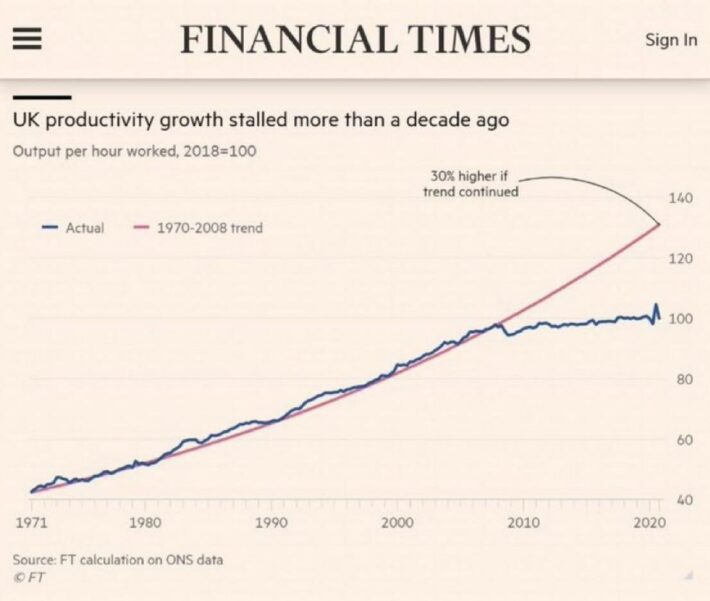I came across this chart recently and it gave me pause for thought as someone whose life work is designed to improve productivity. It shows that from 2008, although we know technologies have been growing in power, productivity growth suddenly dropped away from the trendline following the global financial crisis. Why?

This is where I fall back on an old story as a developer trying to make things more efficient. I worked with my colleagues to bring a client company the equivalent of about ten hours a day of labour saving due to using a well structured database for better data integrity over their previous ‘loose’ system. As they expanded, each branch would save at least an hour of time, and they were no longer capacity bound at each branch where more customers would linearly increase administrative work in a difficult recruiting environment. This would provide a return on investment (ROI) of less than a year.
It worked exceptionally well and the person we’d worked with said their staff were even worried redundancies might be on the way! This was never going to be the case in a growing company, because there’s an infinite amount of work to do.
All was good.
Then for some reason, our contact’s role was diminished and they eventually left the company. And the knowledge of the improvement left as well. The board’s innate distrust of anyone and their perception of us as no more than a cost base resulted in a great difficulty for us to help them without dramatically increasing costs by gold-plating every spec and decision.
This left the client unable to gain for advantage by exploiting our skills. It was difficult for us to see, and we could do little for them other to look for cost savings when, in reality, they needed to implement cost savings by using us more. Instead they opted for a recruitment based strategy to feed their growth and we parted ways as they shifted the system to a maintenance partner.
In all my thirty years of development experience I’ve seen this again and again. Instead of sticking with a solid set of developers who have learned your business details, chop and change to save money. Treat developers as a cost base and you lose so much knowledge that you’ll fail to gain productivity nearly as quickly as you could treating it as a partnership.
I don’t feel this is unique. I see lots of projects following an arc of big development then a cost reduction period which ends up losing the momentum of ongoing improvement.
Solving the productivity paradox
A strategy I now suggest when selling is to spend 60% of what you thought of on your project in year 1, then 40% in year two, 30% in year three, and then 20% a year throughout the product lifecycle. Software isn’t like building a bridge where things stabilise then stay them same for thirty years, sadly.
Fundamentally, I think corporate culture around custom software became both cautious and speculative following the global financial crash of 2008 and only invested in technology if it felt like it would create some impressive unicorn of an offering. We saw lots of developers tied up with venture capital chasing big things like blockchain and AI whilst ignoring the importance of daily incremental improvement that adds up to a huge return over time.
The answer then, is that if you have access to capital, you should stop chasing unicorns and start thinking about continuous pragmatic development aimed at dealing with all the little productivity blocks in your firm. Look to Kaizen style methodologies to help with structuring your processes around this.
What do you think? Feel free to comment!
